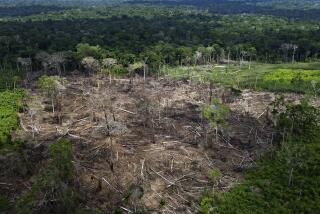Drug Companies Turn to Nature for New Medicines
- Share via
Spurred by advances in biotechnology, drug companies are showing renewed interest in exploring nature for new medicines.
At the forefront of the trend is pharmaceutical giant Merck & Co. Inc., which has entered into an agreement with a scientific institute in Costa Rica to screen plants, insects and microorganisms found in the tropical nation’s lush forests.
Lynn Caporale, a biochemist and scientific adviser at Merck, said drug companies have a self-interest in saving tropical forests, which contain millions of organisms not yet examined for potential medical benefits.
Without the forests, she said, the industry’s ability to make drugs to fight new diseases may be severely constrained.
“Twenty years ago, nobody heard of AIDS,” Caporale said. “What’s coming 20 years from now?”
Nature has long been tapped for medicine. Most pharmaceuticals either have been derived from plants, bacteria or fungi, or are based on molecules initially observed in them. Drugs produced from Madagascar’s rosy periwinkle, for instance, are effective against certain kinds of childhood leukemia.
But isolating and testing useful substances from nature required substantial time and labor. Thousands of plants had to be screened to find one with medical benefits. In an attempt to remove randomness from the search, scientists turned instead to chemistry, designing drugs based on scientific principles.
The resurgent interest in nature follows recent technical advances that make it possible to screen large numbers of molecules rapidly. These advances opened the way for such ventures as the Merck agreement.
Under the two-year pact, Merck will pay Costa Rica’s National Institute of Biodiversity $1 million for samples to be evaluated for possible pharmaceutical and agricultural uses.
The nonprofit institute, created in 1989 on the recommendation of the Costa Rican government, will earn royalties on the sale of any Merck products developed from there.
Conservationists say the agreement is important because it provides money upfront to Costa Rica. Otherwise, the country might have to wait 20 years before a product was developed, tested, marketed and earning royalties.
“In 20 to 30 years, much of the rain forest may disappear,” said Thomas Eisner, a professor of biology at Cornell University who helped broker the Merck pact.
Simply storing plant tissues in banks won’t work because many plants do not produce high concentrations of chemicals until they are threatened, perhaps by an approaching insect, Eisner said. Once a compound has been identified, it usually can be replicated synthetically.
Eisner said prospecting for drugs in nature need not be totally random. For instance, the biologist discovered a potential insect repellent in an endangered Florida mint plant after observing that its leaves were untouched despite the presence of many voracious insects.
Local healers or medicine men also can guide researchers to potential cures. Shaman Pharmaceuticals of San Carlos is going to herbalists or “shamans” in various countries in search of new drugs.
Company officials say they already have discovered an antiviral agent in a South American plant that may be capable of fighting a broad range of respiratory viruses.
The importance of maintaining indigenous tribes familiar with the forests was underscored in recent research by Robert A. Voeks, an associate professor at Cal State Fullerton.
Voeks initially concluded that more recently planted forests in Brazil contained more medicinals than old-growth forests. But he later realized that the healers who guided his search--descendants of African slaves, not the original inhabitants--were simply unfamiliar with the old-growth forests.
The indigenous tribes had been wiped out by disease, and with them went their knowledge of the rain forest. Voeks said that native people who have not been displaced in the Amazon do, in fact, collect many medicinals from virgin rain forests.
“Even if we do save the (medicinal) species,” said Voeks, “if the indigenous peoples are either driven from their land or die out, then we’ve lost their ethnomedicinal system.”
The National Cancer Institute screens about 4,500 plant samples a year. If a compound is shown to have potential anti-cancer properties, the Institute invites scientists from the country where the sample originated to examine the material in American laboratories with American scientists.
If a drug is produced, the government requires the pharmaceutical company receiving the patent license to share a percentage of royalties with the country where the sample originated, said Gordon Cragg, chief of the natural products branch of the Cancer Institute.
The institute worked with plant samples from 1960 to 1980 but then “de-emphasized” the research because nothing new was being discovered, Cragg said. In 1985, a new screening technique was developed “so people felt we should go back to nature.”
The relatively recent discovery of taxol, a promising cancer drug obtained from the bark of Pacific yew trees, has sparked some of the renewed attention, Cragg said.
Such finds remain long shots. The chance of finding a similar anti-cancer drug from nature is one in 50,000, he said.
But even if nature’s medicinal bounty proves to be exaggerated, he added, “all you’ve got to do is discover two or three good drugs in the area of cancer or AIDS, and you’ve shown the worth of these resources.”
Merck’s Caporale is confident the company will not leave Costa Rica empty-handed. She predicts that a substance will be discovered within five years that will at the least give researchers a lead on a new drug.
For instance, a molecule might be found that blocks an enzyme needed by the AIDS virus to spread, Caporale said, but the molecule may not last long enough in the body to be effective.
“So we would have to improve it with a major chemistry effort by making new molecules based on what we have learned” from nature, she said.







